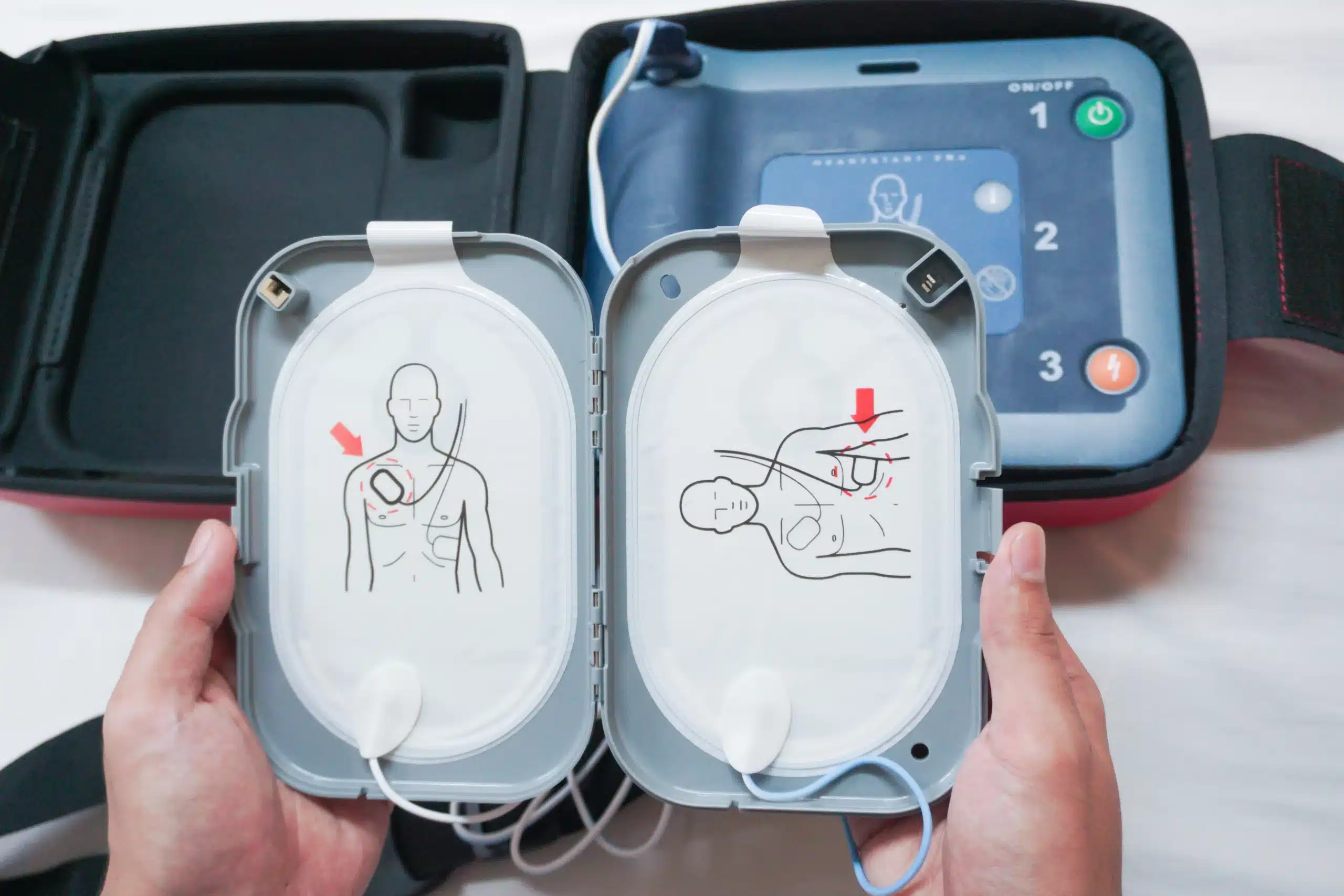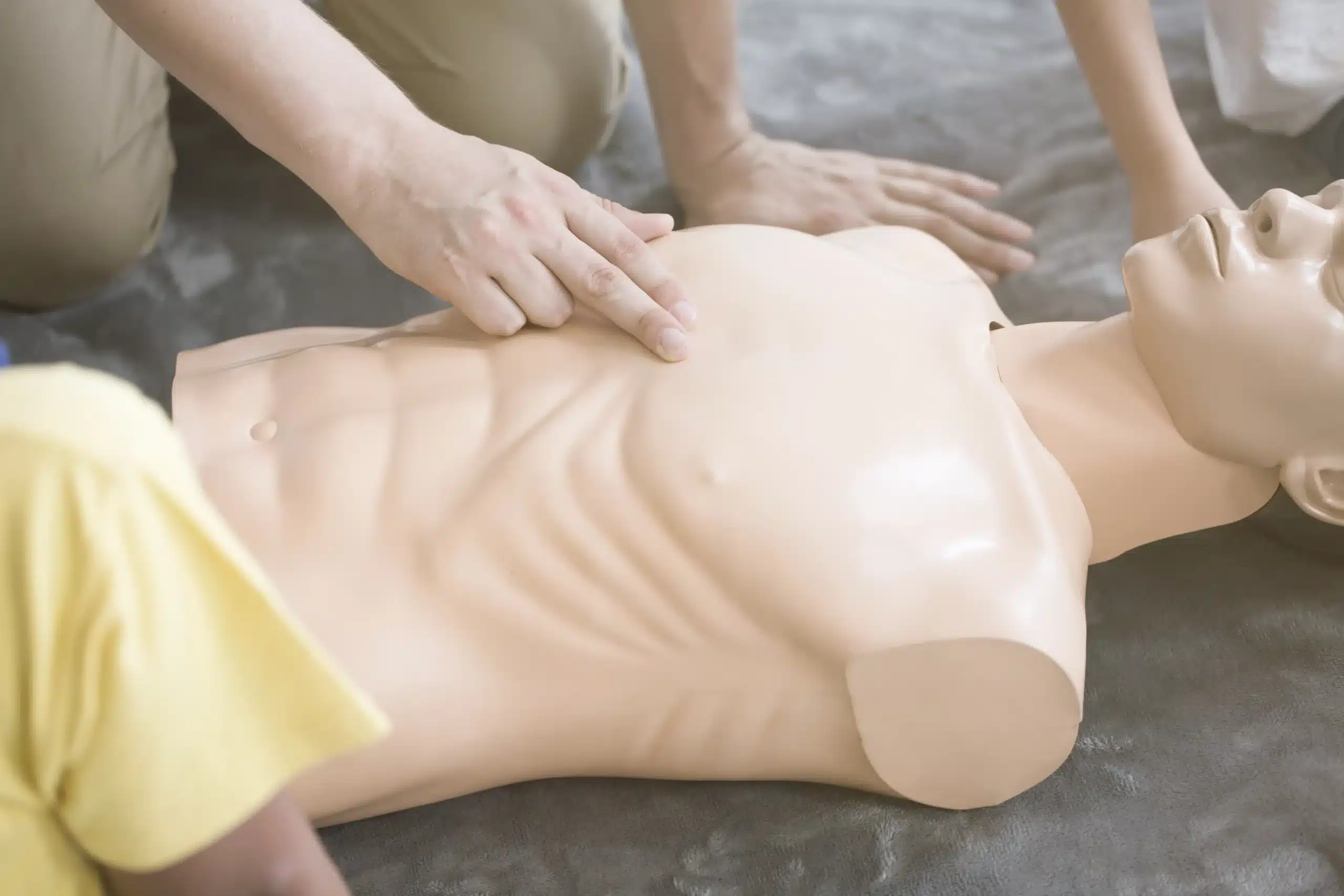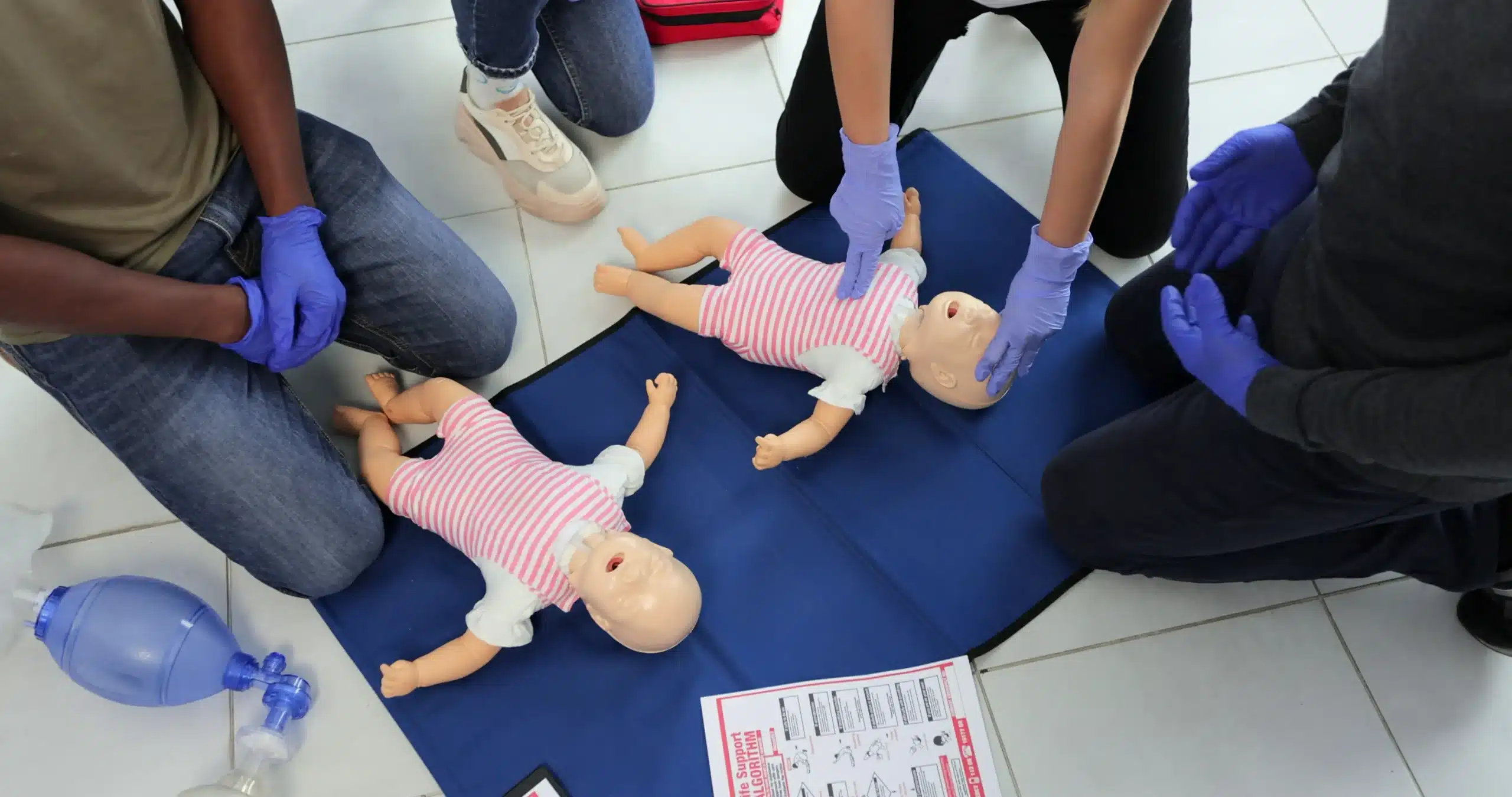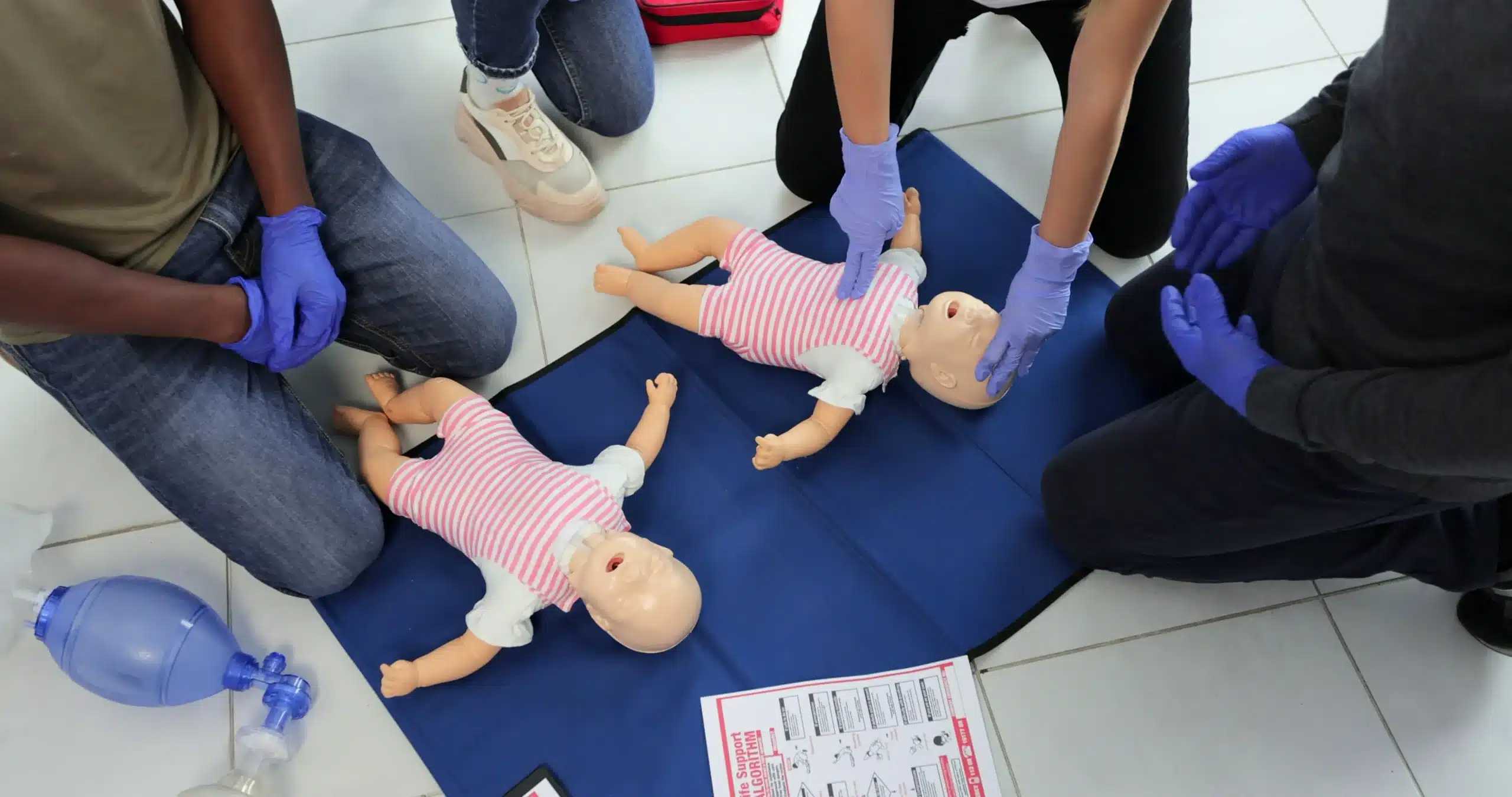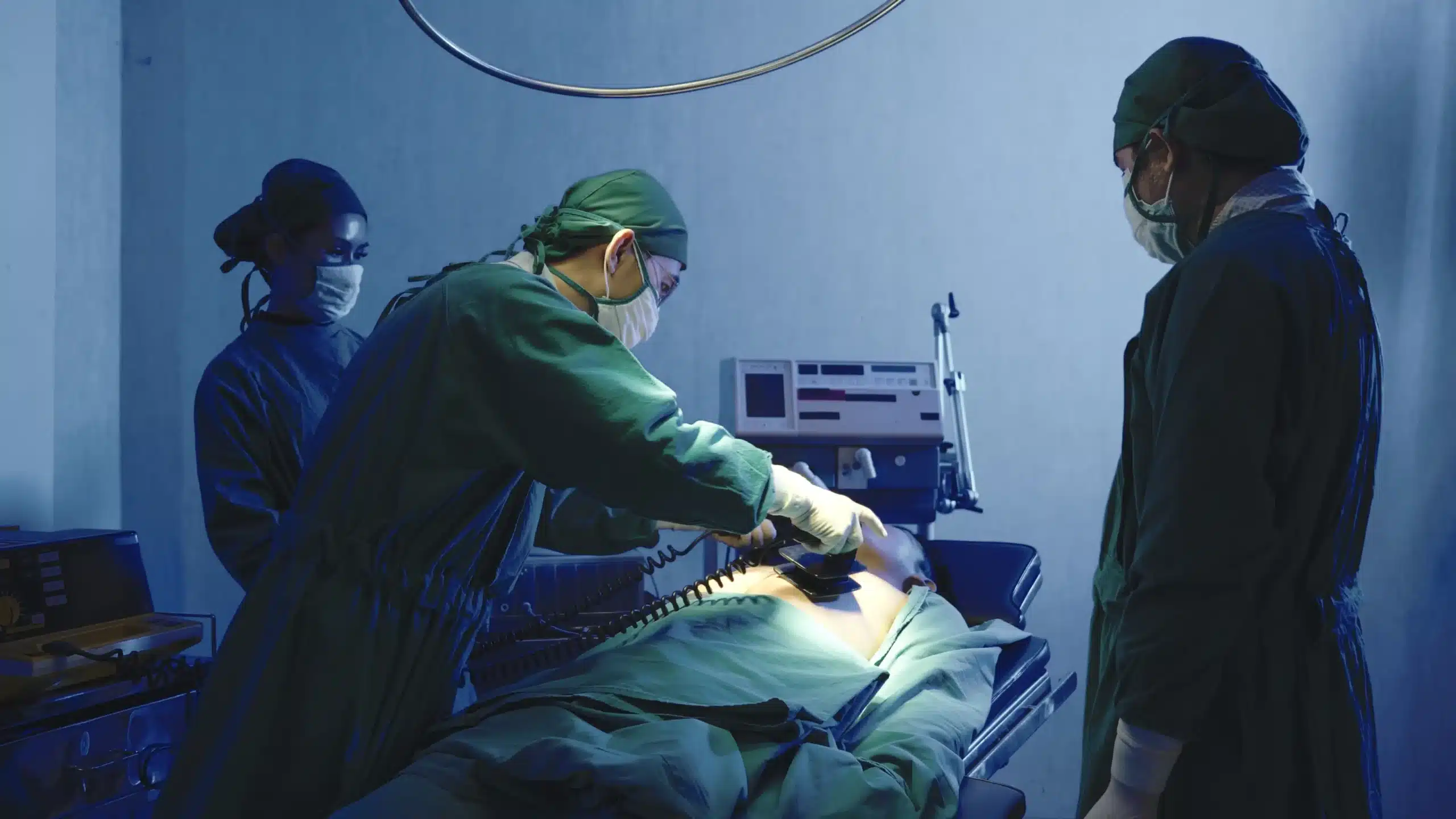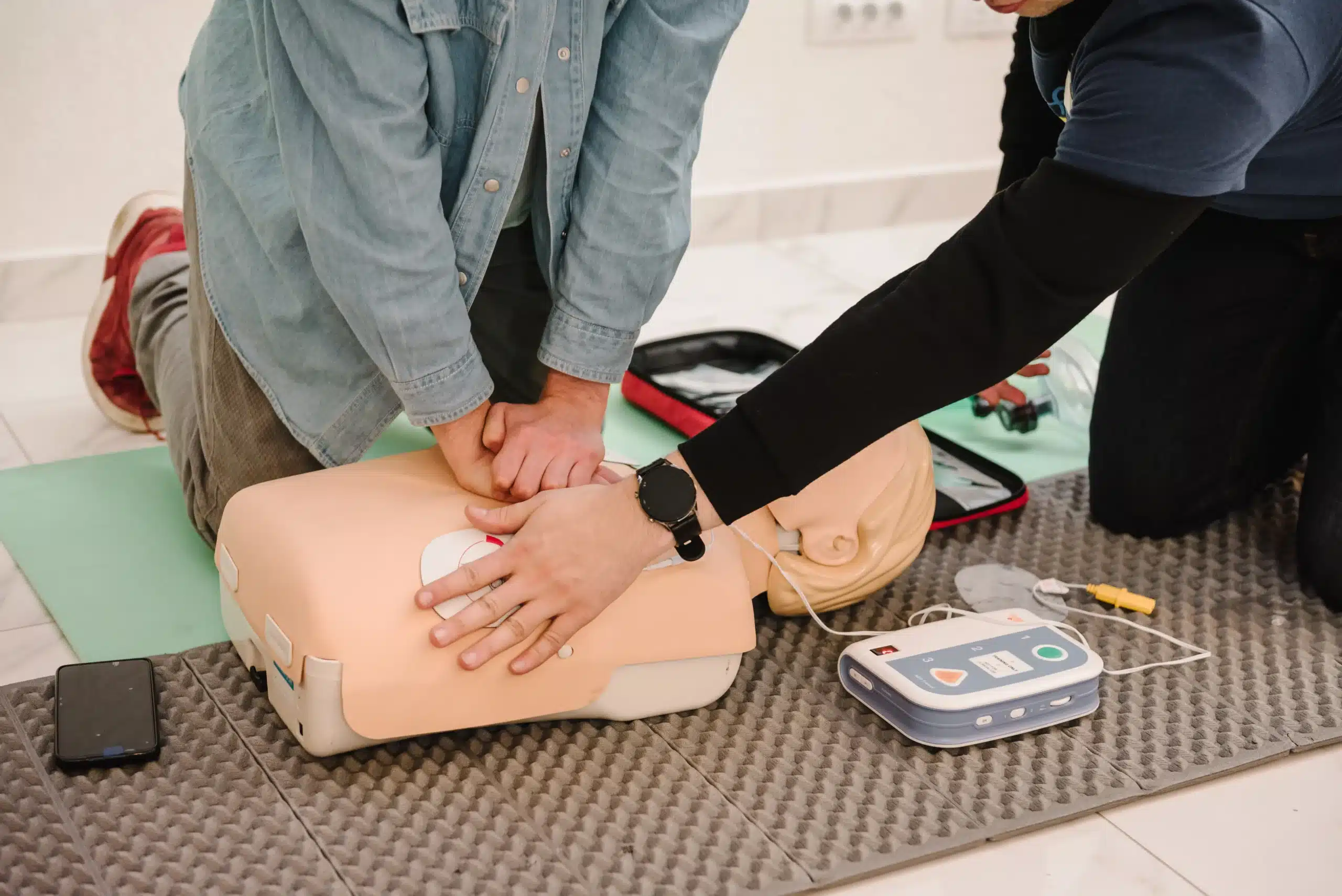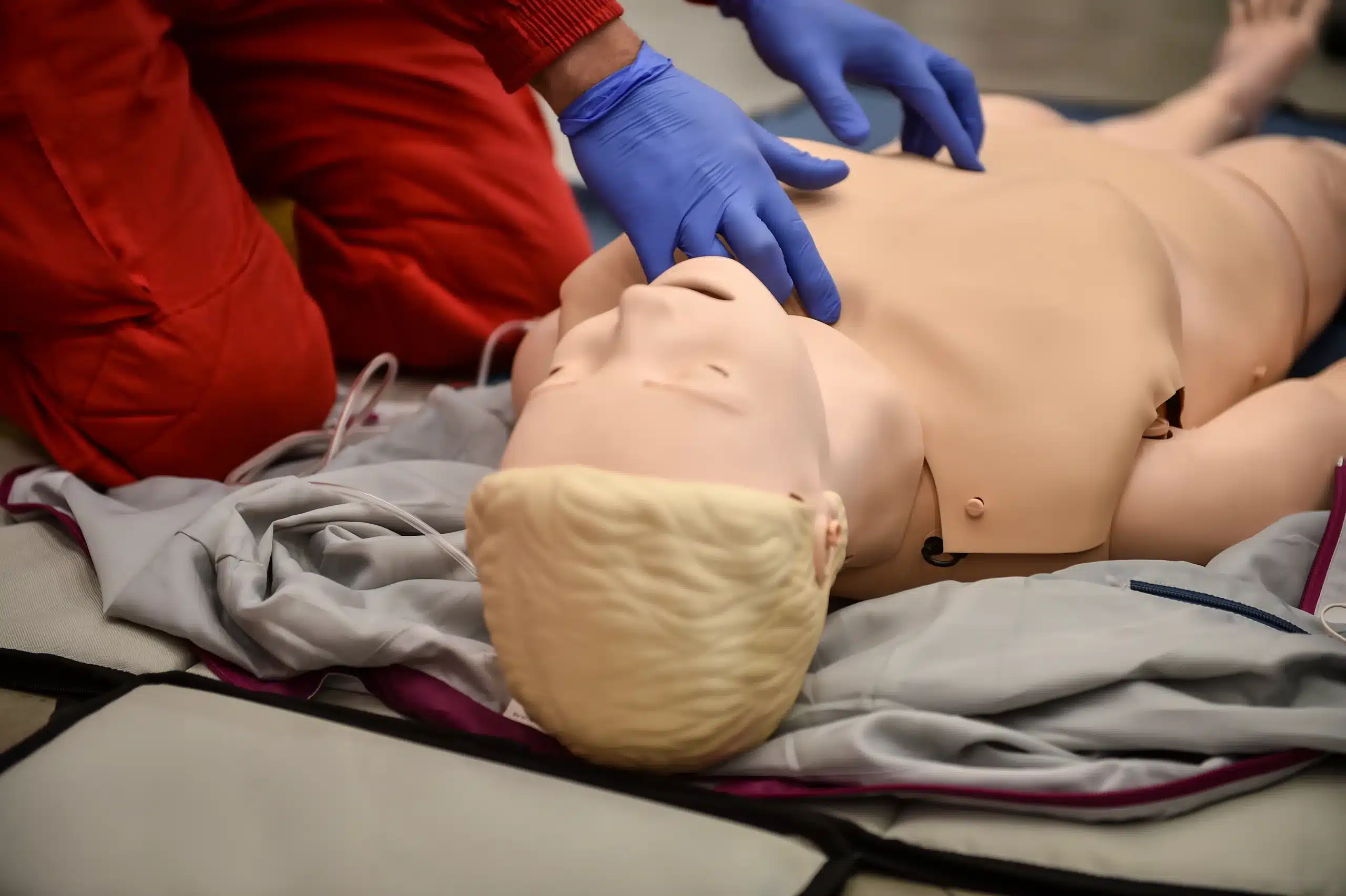Protecting your employees and creating a safe work environment is a top priority for any responsible business. On-site CPR training in Alameda provides a proactive solution, empowering your team to respond confidently during medical emergencies. This training goes beyond simply checking a box—it cultivates a culture of preparedness and quick action, giving your employees the skills and confidence to potentially save lives. This guide will walk you through everything you need to know about on-site CPR training, from the types of courses available to choosing the right provider and preparing your workplace for a successful training experience.
Key Takeaways
- On-site CPR training offers practical benefits: It eliminates travel time for employees, allows for customized training scenarios, and fosters a stronger sense of teamwork and preparedness within an organization.
- Different CPR courses cater to various needs: From basic CPR/AED and first aid to advanced certifications like BLS, ACLS, and PALS, choose the course that aligns with your specific professional requirements and responsibilities.
- Maximize the impact of CPR training through ongoing practice: Integrate CPR skills into your emergency response plans, create a culture of preparedness, and encourage regular refresher courses to maintain proficiency and confidence.
What is On-Site CPR Training?
On-site CPR training brings the classroom to you, eliminating the hassle of coordinating travel to an off-site facility. It’s a convenient and efficient way to equip your team with life-saving skills. A certified instructor comes to your workplace or designated location, providing a personalized approach that offers greater flexibility in scheduling and can be more cost-effective, especially for larger groups. Safety Training Seminars specializes in this type of tailored, on-site training.
On-site CPR training typically covers essential skills like CPR, AED use, and first aid. Some courses also include advanced training, such as Basic Life Support (BLS) and Pediatric Advanced Life Support (PALS). The curriculum can be customized to address the specific needs of your workplace, ensuring your team is prepared for a range of potential emergencies. This tailored approach is particularly beneficial for workplaces with unique hazards or specific industry regulations. For example, healthcare providers might require more in-depth training than office workers. Learn more about CPR and first-aid certification courses offered by Safety Training Seminars.
Benefits of On-Site CPR Training
Bringing CPR training directly to your Alameda workplace offers several key advantages. On-site training eliminates travel time for employees, minimizing disruptions to their workday. It also allows for a more tailored learning experience, focusing on the specific hazards and emergency scenarios relevant to your industry. For example, construction workers might require training on CPR for traumatic injuries, while childcare providers would benefit from specialized training on infant and child CPR. This targeted approach ensures your team develops the precise skills they need to respond effectively in real-life situations. Safety Training Seminars offers on-site CPR training in Alameda and throughout Alameda County.
Beyond the practical advantages, on-site CPR training fosters a stronger sense of teamwork and preparedness within your organization. Learning together creates a shared experience, building confidence and encouraging open communication about safety protocols. CPR training empowers employees to take charge during emergencies, potentially saving lives and minimizing the severity of injuries. It demonstrates a clear commitment to employee well-being, cultivating a safety-conscious culture that values preparedness and quick action. This proactive approach reduces the risk of accidents and strengthens employee morale, creating a more positive work environment. Investing in on-site training shows your team you prioritize their safety, which can lead to increased job satisfaction and loyalty. Having a team trained in first aid can also help reduce workplace injuries and accidents. Consider
CPR Courses for On-Site Training
Different CPR courses cater to various needs and professional levels. Choosing the right course ensures you gain the appropriate skills and knowledge for your specific situation. Here’s a breakdown of common CPR courses offered in on-site training programs:
Basic Life Support (BLS)
The Basic Life Support (BLS) course is crucial for healthcare providers, equipping them with the skills to perform high-quality CPR and effectively use an AED. This course emphasizes teamwork, high-performance CPR, and integrating science into resuscitation techniques. It covers single-rescuer and team-based CPR for adults, children, and infants, along with AED use, relief of choking, and rescue breathing.
Advanced Cardiovascular Life Support (ACLS)
Advanced Cardiovascular Life Support (ACLS) training targets healthcare professionals involved in managing cardiovascular emergencies, including cardiac arrest. This advanced course covers a broader range of interventions, including airway management, pharmacology, and effective team dynamics during resuscitation.
Pediatric Advanced Life Support (PALS)
Specifically designed for healthcare providers working with infants and children, the Pediatric Advanced Life Support (PALS) course focuses on recognizing and treating pediatric respiratory and cardiac emergencies. It emphasizes the systematic approach to pediatric assessment, resuscitation, and stabilization.
Heartsaver CPR/AED
Heartsaver CPR/AED courses are perfect for anyone wanting to learn essential life-saving skills, including CPR and AED use. These courses are suitable for community members, workplace responders, and those who don’t require healthcare provider-level certification. They provide the confidence to respond effectively in emergencies.
First Aid
First Aid training covers a wide range of skills needed to manage common medical emergencies, from injuries like cuts and burns to sudden illnesses. Learning first aid empowers you to provide immediate care until professional medical help arrives, potentially minimizing the severity of the situation. Often combined with CPR training, first aid certification is a valuable asset in any setting.
Top On-Site CPR Training Providers in Alameda
Finding the right CPR training provider can feel overwhelming, but several excellent options are available right here in Alameda. To simplify your search, I’ve compiled a list of reputable providers offering on-site training, bringing the instruction directly to your workplace.
Safety Training Seminars
Safety Training Seminars offers a comprehensive range of American Heart Association (AHA) certified courses, including CPR, BLS (Basic Life Support), ACLS (Advanced Cardiovascular Life Support), PALS (Pediatric Advanced Life Support), and First Aid. They offer classes daily, including weekends, and issue same-day certification cards. A major advantage is their low-price guarantee for Alameda County. Explore their CPR and First Aid certification courses, EMSA Child Care Health & Safety training, and group discounts.
Lifesavers CPR & First Aid
Lifesavers CPR & First Aid focuses on CPR and First Aid certification, along with AED equipment sales and program management. They emphasize the critical role of CPR/AED training in saving lives. With evening and Saturday classes, plus on-site training throughout the San Francisco Bay Area, they offer flexible scheduling. Visit their website for more information.
CPR Education
CPR Education provides various courses in Alameda, including AHA Heartsaver courses, BLS for healthcare providers, and Pediatric First Aid. Their instructors bring real-world experience as firefighters and paramedics. They also help businesses comply with workplace safety regulations like OSHA and EMSA. Learn more at CPR Education.
American Heart Association Training Centers
For those interested in becoming CPR instructors, the American Heart Association (AHA) offers an Instructor Course. This program prepares individuals with current AHA Provider certification to teach BLS or Heartsaver® courses. AHA Training Centers provide the necessary resources and support. Explore the AHA instructor program.
Red Cross Training Centers
The Red Cross also offers instructor training. Red Cross Training Centers require affiliation with a Red Cross Training Provider. This provides access to their Instructor Portal for course management and reporting. Learn about the Red Cross instructor program.
Choose the Right On-Site CPR Training Provider
Finding the right on-site CPR training provider is crucial for ensuring your team receives high-quality instruction and gains the confidence to respond effectively in emergencies. Here’s what to consider when making your decision:
Instructor Qualifications and Experience
Experienced, certified instructors are key to a successful training. Look for providers whose instructors hold certifications from reputable organizations like the American Heart Association (AHA). A good instructor not only knows the material but also has a passion for teaching and can create a comfortable learning environment. AHA Instructor training equips individuals with the skills to effectively deliver lifesaving knowledge. Instructors should be proficient in performing CPR and possess strong communication skills to convey complex information clearly. Check if the provider’s instructors have experience working with groups similar to yours, such as healthcare professionals or corporate teams.
Course Offerings and Specializations
Different workplaces have different needs. Ensure the provider offers the specific courses required for your industry, whether it’s basic CPR and First Aid or more specialized training like ACLS or PALS. A comprehensive training provider will offer a range of courses to meet diverse needs. Some providers also offer combined courses, such as CPR and First Aid certification, which can be a convenient and cost-effective option. If your workplace requires specialized training, like EMSA Child Care Health & Safety, confirm the provider offers these specialized certifications. Consider also supplemental courses such as BLS and NRP.
Pricing and Group Discounts
Compare pricing structures from different providers, keeping in mind that the cheapest option isn’t always the best. Look for providers who offer transparent pricing and group discounts for on-site training. While cost is a factor, prioritize the quality of instruction and certification over rock-bottom prices. For example, while basic CPR training might start around $35 per person, a combined CPR and First Aid course from Safety Training Seminars could be around $140, including online and in-person components. Consider the overall value and what’s included in the price. Check out Safety Training Seminars’ low price guarantee.
Scheduling Flexibility
On-site training should fit seamlessly into your workplace schedule. Choose a provider that offers flexible scheduling options, including evenings and weekends. The ability to schedule training daily, including weekends, minimizes disruption to your operations. Providers like Lifesavers CPR offer convenient evening and Saturday classes to accommodate busy schedules. Discuss your scheduling needs upfront to ensure the training fits your team’s availability.
Certification Process and Validity
Verify that the provider offers certifications recognized by reputable organizations like the AHA. This ensures your team receives credentials that are widely accepted and valid for two years. AHA-certified courses provide nationally recognized credentials. Clarify the certification process and how long the certification is valid (typically two years) with the provider. Understanding the certification’s validity ensures your team remains compliant with industry standards.
What to Expect During On-Site CPR Training
Knowing what to expect can help you feel prepared and confident on the day of your training. Here’s a glimpse into a typical on-site CPR class:
Course Structure and Duration
On-site CPR training is designed to be comprehensive and efficient. Classes typically follow a blended learning approach, combining online coursework with in-person skills practice and assessment. This allows you to learn the fundamental concepts at your own pace before practicing the techniques in a hands-on setting. Safety Training Seminars holds classes daily, including weekends, offering flexibility for busy schedules. Same-day certification cards are issued upon successful completion, so you leave the class ready to respond to emergencies.
Hands-on Practice
The core of on-site CPR training lies in the hands-on practice. You’ll work with a CPR training mannequin, learning the precise hand placement and depth of compressions needed for effective CPR. Instructors guide you through various scenarios, including adult, child, and infant CPR, providing feedback and ensuring you’re performing the techniques correctly. This practical experience builds your muscle memory and confidence, preparing you to act quickly and effectively in a real emergency.
Assessment and Certification
After the hands-on practice, you’ll complete an assessment to demonstrate your proficiency in CPR techniques. This typically involves performing CPR on a mannequin while the instructor evaluates your skills. Alameda CPR Classes offers same-day certification upon successful completion of the course and skills test. You’ll receive a certification card valid for two years, demonstrating your readiness to provide CPR in critical situations.
Prepare Your Workplace for On-Site CPR Training
Hosting CPR training at your workplace is convenient and cost-effective, especially for larger groups. A little preparation ensures a smooth and successful training experience for everyone. Here’s how to get ready:
Space Requirements
On-site training brings the CPR class directly to your location. You’ll need a room large enough to comfortably accommodate all participants and the instructor. The space should allow for both instruction and hands-on practice. A conference room, classroom, or even a large break room can often work well. Ensure you have enough space for participants to spread out and practice skills like chest compressions and rescue breaths without feeling cramped.
Equipment Needed
While the training provider, such as Safety Training Seminars, typically supplies the mannequins, AED trainers, and other specialized equipment, you should confirm this beforehand. You’ll need to provide tables and chairs for the instructional portion. Easy access to a restroom and a water cooler or other refreshments is also a good idea. A whiteboard or flip chart can be helpful for the instructor, but isn’t essential. Investing in workplace CPR training and AEDs demonstrates a commitment to employee safety and preparedness.
Participant Preparation
Before the training, encourage your team to wear comfortable clothing suitable for physical activity. Inform them of the course duration and any scheduled breaks. It’s helpful to send out any pre-course materials provided by the instructor, such as a basic overview of CPR or FAQs. Addressing any pre-training jitters can improve the learning experience. Many people have concerns about performing CPR, like injuring someone or performing mouth-to-mouth. Let your team know the instructor will address these concerns and create a supportive learning environment. By making CPR training readily available, you demonstrate a commitment to employee well-being and a safe work environment.
Schedule On-Site CPR Training
Bringing a CPR class directly to your workplace, school, or community center is easy with on-site training. This convenient option lets you train a group without the hassle of traveling to a separate facility. Companies like Safety Training Seminars offer on-site group training and certification for various courses, including BLS, ACLS, PALS, First Aid, and CPR.
Booking Process
Most providers make booking simple. You can typically find a contact form or phone number on the provider’s website. Be prepared to share some key information, such as your preferred training date, the number of participants, and the specific course you need. Some providers, like Safety Training Seminars, may offer online booking systems for added convenience. Confirming details like location access and required equipment beforehand will help the training run smoothly.
Cancellation Policies
Life happens, and sometimes you need to reschedule. Cancellation policies vary by provider, so check with your chosen company about their terms for rescheduling or canceling a class. Understanding these policies upfront can save you time and potential fees.
Group Size Considerations
Training a larger group can often lead to cost savings per person. Keep in mind that a minimum number of participants or a minimum fee may be required for on-site training. This ensures the training remains cost-effective for the instructor. CPR training is a valuable investment in your team, increasing their confidence and preparing them to handle workplace emergencies.
Maximize the Impact of CPR Training
CPR training is a vital investment in the safety and well-being of your workplace or community. But simply completing a course isn’t enough. To truly maximize the impact of CPR training, you need to foster a culture of preparedness, integrate these skills into your emergency response plans, and encourage regular practice and refreshers. Let’s explore how to make CPR training a cornerstone of your safety protocols.
Create a Culture of Preparedness
Think of CPR training as more than just a checkbox on a compliance list. It’s about empowering individuals to confidently respond to emergencies. When people know they have the skills to potentially save a life, it creates a sense of shared responsibility and preparedness. This proactive approach can significantly improve outcomes during crises. As CPR Training Company points out, implementing workplace CPR training helps create this culture of preparedness, ensuring employees feel equipped to handle emergencies. This increased confidence translates to quicker reactions and more effective responses when every second counts. Consider promoting CPR training through regular awareness campaigns, highlighting success stories, and recognizing individuals who actively participate.
Integrate CPR Skills into Emergency Response Plans
Having trained individuals is a great start, but integrating CPR skills into your formal emergency response plans is crucial. This means clearly outlining the steps to take during a medical emergency, designating CPR-trained responders, and ensuring easy access to necessary equipment like AEDs. Don’t just leave it to chance—make CPR a formalized part of your safety procedures. Regularly review and update your emergency response plans to reflect best practices and incorporate feedback from drills or actual emergency situations.
Practice and Refresh CPR Skills Regularly
CPR skills can fade over time, so regular practice and refresher courses are essential for maintaining proficiency. Hands-on practice, simulations, and regular reviews of key techniques help reinforce learned skills and build muscle memory. This ongoing reinforcement ensures that individuals can effectively apply their training under pressure. As USCPR Online emphasizes, effective CPR training includes hands-on practice and AED usage. Consider scheduling refresher courses annually or bi-annually to keep skills sharp and up-to-date with the latest guidelines. This commitment to ongoing training demonstrates a dedication to safety and preparedness.
Address Common CPR Training Misconceptions
Let’s clear up a few common misconceptions about CPR training that might be holding you back from learning this life-saving skill.
Myth #1: CPR always revives someone. CPR significantly increases the chances of survival during cardiac arrest, but it doesn’t guarantee a revival. It’s essential to have realistic expectations about CPR.
Myth #2: You must be certified to perform CPR. Absolutely anyone can learn and perform CPR. While formal CPR certification provides documented training, don’t hesitate to act in an emergency, even if you’re not certified. Even basic hands-only CPR can make a difference. Learn more about the benefits of hands-only CPR.
Myth #3: Performing CPR incorrectly is harmful. It’s natural to worry about doing something wrong, but the potential for harm is minimal compared to the risk of doing nothing. Learn CPR and don’t let fear prevent you from taking action in a critical situation.
Myth #4: Mouth-to-mouth is always necessary. Hands-only CPR is highly effective and often recommended for untrained bystanders. This simplifies the process and makes it easier for more people to help in emergencies.
Myth #5: Only medical professionals can perform CPR effectively. Anyone can learn CPR with the right training. Don’t underestimate the impact you can have. Training empowers you to respond confidently and potentially save a life. Safety Training Seminars offers a variety of CPR courses in Alameda to equip you with these vital skills.
Related Articles
- How CPR Certification Prepares You for Emergencies – Alameda CPR Classes
- CPR Certification in Alameda: Why Everyone Needs It – Alameda CPR Classes
- CPR Certification: How to Be a Workplace Hero – Alameda CPR Classes
- CPR Training in Oakland: Your Guide to Certification – Alameda CPR Classes
- Free CPR Classes: Your Guide to Life-Saving Skills – Alameda CPR Classes
Frequently Asked Questions
What’s the difference between on-site and off-site CPR training?
On-site training comes to your location—whether that’s your office, community center, or another designated space. Off-site training requires you to travel to the training center. On-site training offers greater flexibility and can be more cost-effective for larger groups. It also allows for a more tailored curriculum, focusing on the specific hazards and emergency scenarios relevant to your workplace.
How do I choose the right CPR course for my team?
Consider your team’s specific needs and the potential emergencies they might face. Basic CPR and First Aid are suitable for most workplaces, while healthcare providers typically require more advanced training like BLS, ACLS, or PALS. If you work with children, PALS certification is essential. A good training provider can help you determine the most appropriate course.
What if I’m nervous about performing CPR in a real emergency?
It’s normal to feel apprehensive, but remember that any action is better than no action. High-quality CPR training emphasizes hands-on practice and builds confidence through realistic scenarios. Focus on the skills you’ve learned and trust your training. Even basic CPR can significantly improve someone’s chances of survival.
How often should we renew our CPR certification?
CPR guidelines and best practices can change, so renewing your certification every two years is recommended. Regular refresher courses help maintain your skills and ensure you’re up-to-date with the latest techniques. This ongoing training reinforces your confidence and preparedness.
What are the benefits of having a CPR-trained team in the workplace?
A CPR-trained team creates a safer and more prepared work environment. It empowers employees to respond effectively in emergencies, potentially saving lives and minimizing the severity of injuries. This proactive approach can also reduce workplace accidents and boost employee morale, demonstrating a clear commitment to employee well-being.


